Circular Economy and Technological Elements in Electric Scooter Design
VerifiedAdded on 2023/06/14
|23
|4436
|460
Report
AI Summary
This report provides a comprehensive analysis of applying circular economy principles to the electric mobility scooter industry, focusing on sustainable manufacturing practices. It begins by introducing the concept of the circular economy as an alternative to the linear 'take-make-dispose' model, emphasizing the importance of integrating technological advancements for true sustainability. The report details the production process of electric mobility scooters, highlighting key components and functional groups, and then delves into the principles of sustainable manufacturing, particularly closed-loop systems and the 6R framework (Reduce, Reuse, Recycle, Recover, Redesign, Remanufacture). It explores technological elements crucial for circular economy implementation, emphasizing the extension of product lifecycles through redesign and innovation. Furthermore, the report investigates waste management strategies for components like lithium batteries and permanent magnets, advocating for recycle-friendly product designs. Finally, it touches upon the triple bottom line (economic, environmental, and social) assessment, focusing on the economic pillar and recycling opportunities within the electric scooter manufacturing process. Desklib offers a variety of solved assignments and study resources for students.

PM
THE CIRCULAR ECONOMY
THE CIRCULAR ECONOMY
Paraphrase This Document
Need a fresh take? Get an instant paraphrase of this document with our AI Paraphraser
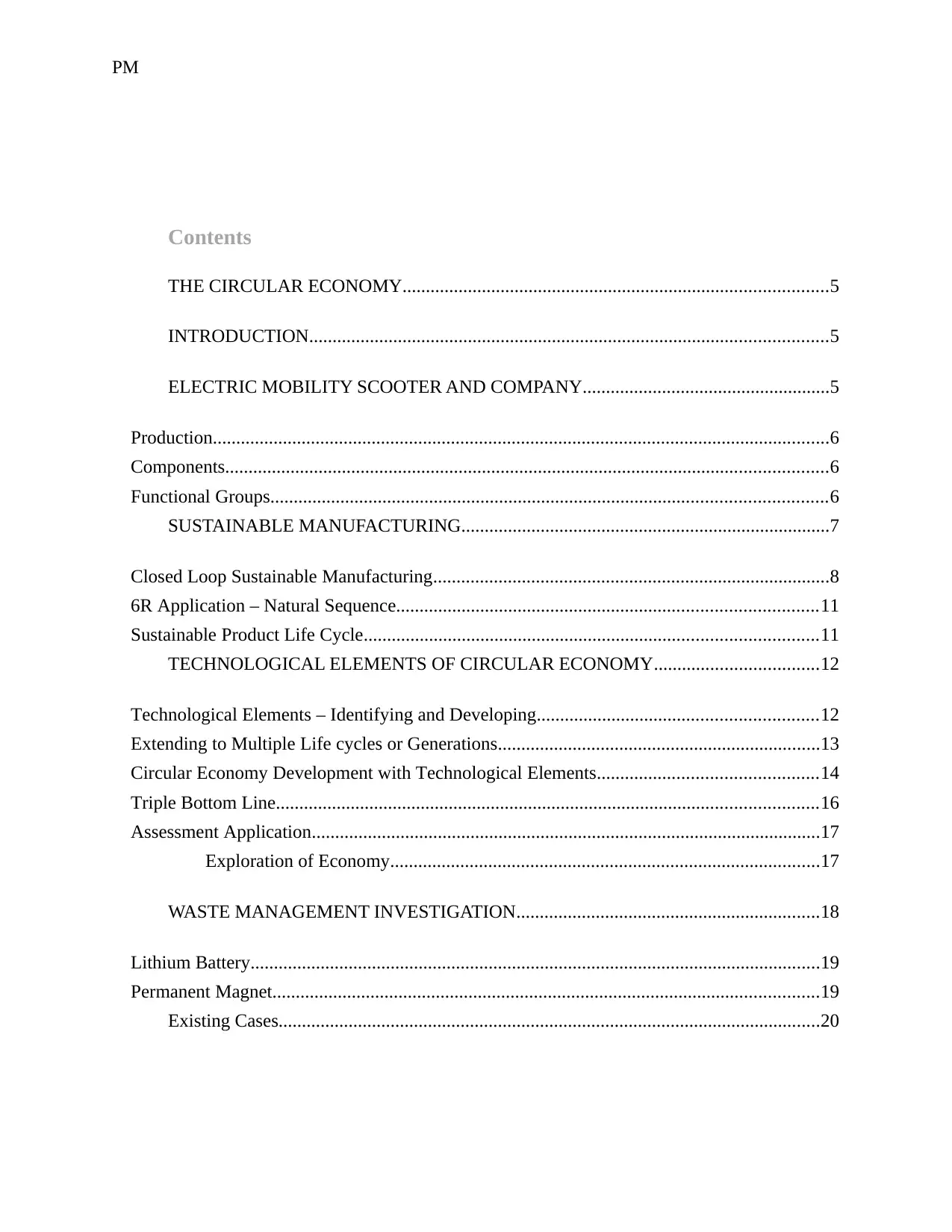
PM
Contents
THE CIRCULAR ECONOMY...........................................................................................5
INTRODUCTION...............................................................................................................5
ELECTRIC MOBILITY SCOOTER AND COMPANY.....................................................5
Production....................................................................................................................................6
Components.................................................................................................................................6
Functional Groups.......................................................................................................................6
SUSTAINABLE MANUFACTURING...............................................................................7
Closed Loop Sustainable Manufacturing.....................................................................................8
6R Application – Natural Sequence..........................................................................................11
Sustainable Product Life Cycle.................................................................................................11
TECHNOLOGICAL ELEMENTS OF CIRCULAR ECONOMY...................................12
Technological Elements – Identifying and Developing............................................................12
Extending to Multiple Life cycles or Generations.....................................................................13
Circular Economy Development with Technological Elements...............................................14
Triple Bottom Line....................................................................................................................16
Assessment Application.............................................................................................................17
Exploration of Economy............................................................................................17
WASTE MANAGEMENT INVESTIGATION.................................................................18
Lithium Battery..........................................................................................................................19
Permanent Magnet.....................................................................................................................19
Existing Cases....................................................................................................................20
Contents
THE CIRCULAR ECONOMY...........................................................................................5
INTRODUCTION...............................................................................................................5
ELECTRIC MOBILITY SCOOTER AND COMPANY.....................................................5
Production....................................................................................................................................6
Components.................................................................................................................................6
Functional Groups.......................................................................................................................6
SUSTAINABLE MANUFACTURING...............................................................................7
Closed Loop Sustainable Manufacturing.....................................................................................8
6R Application – Natural Sequence..........................................................................................11
Sustainable Product Life Cycle.................................................................................................11
TECHNOLOGICAL ELEMENTS OF CIRCULAR ECONOMY...................................12
Technological Elements – Identifying and Developing............................................................12
Extending to Multiple Life cycles or Generations.....................................................................13
Circular Economy Development with Technological Elements...............................................14
Triple Bottom Line....................................................................................................................16
Assessment Application.............................................................................................................17
Exploration of Economy............................................................................................17
WASTE MANAGEMENT INVESTIGATION.................................................................18
Lithium Battery..........................................................................................................................19
Permanent Magnet.....................................................................................................................19
Existing Cases....................................................................................................................20
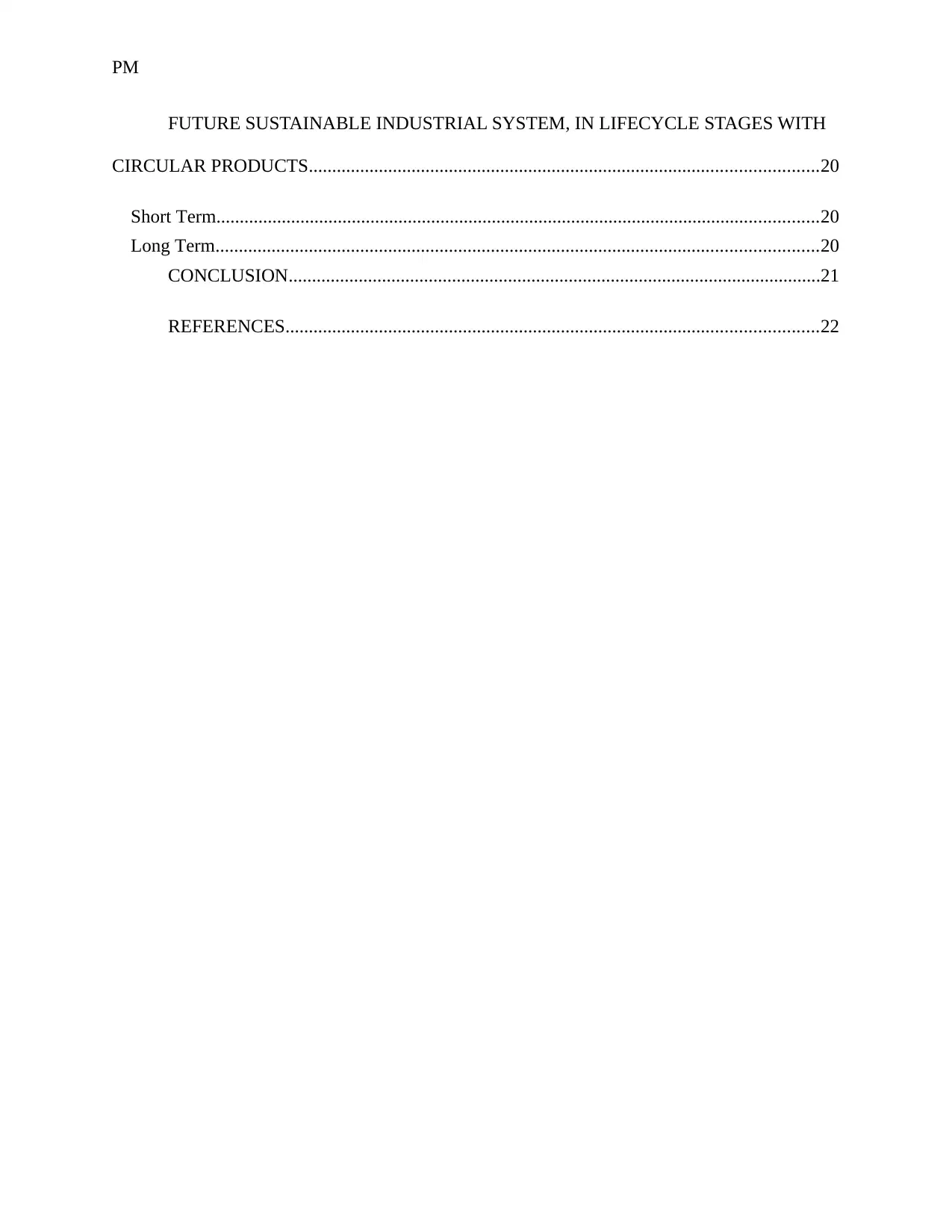
PM
FUTURE SUSTAINABLE INDUSTRIAL SYSTEM, IN LIFECYCLE STAGES WITH
CIRCULAR PRODUCTS.............................................................................................................20
Short Term.................................................................................................................................20
Long Term.................................................................................................................................20
CONCLUSION..................................................................................................................21
REFERENCES..................................................................................................................22
FUTURE SUSTAINABLE INDUSTRIAL SYSTEM, IN LIFECYCLE STAGES WITH
CIRCULAR PRODUCTS.............................................................................................................20
Short Term.................................................................................................................................20
Long Term.................................................................................................................................20
CONCLUSION..................................................................................................................21
REFERENCES..................................................................................................................22
⊘ This is a preview!⊘
Do you want full access?
Subscribe today to unlock all pages.

Trusted by 1+ million students worldwide
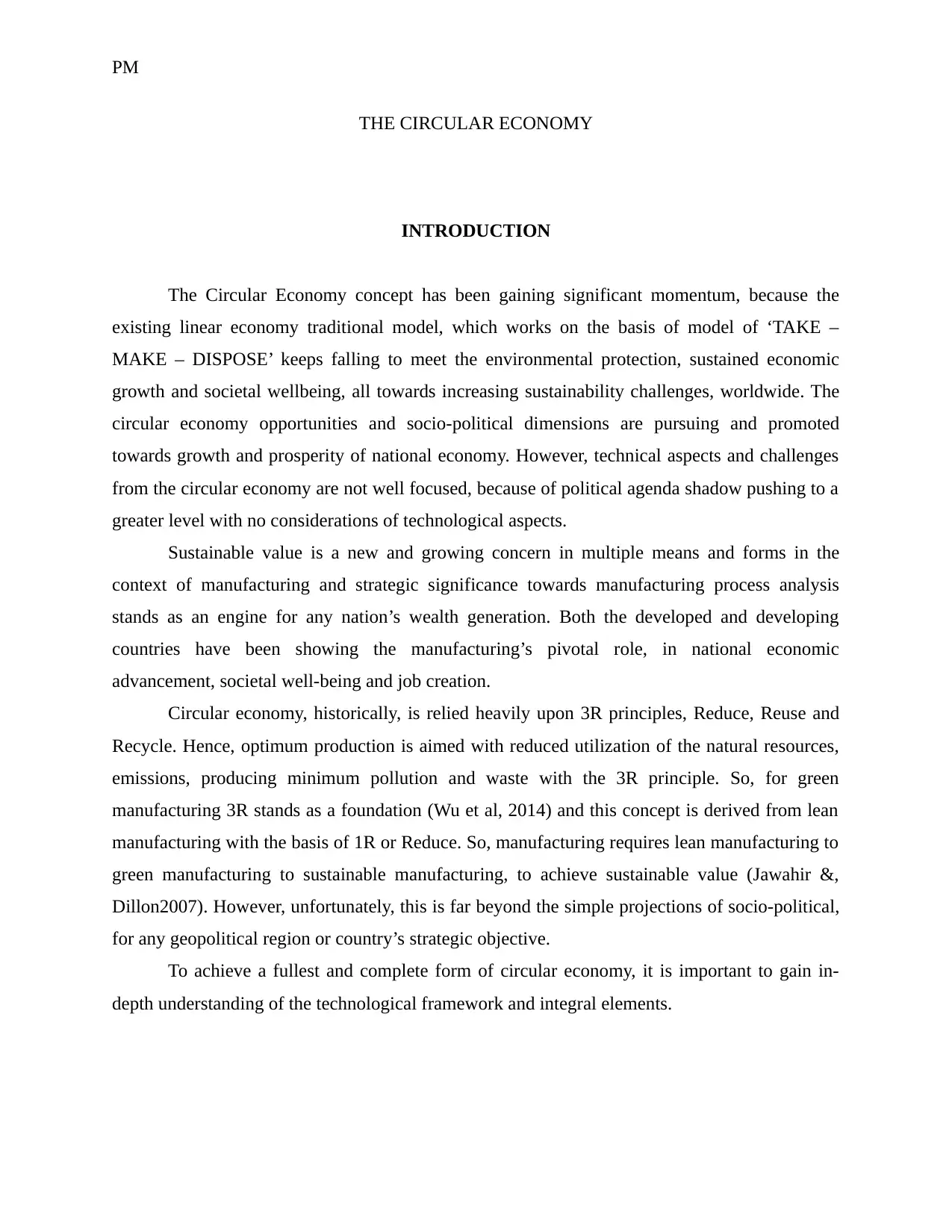
PM
THE CIRCULAR ECONOMY
INTRODUCTION
The Circular Economy concept has been gaining significant momentum, because the
existing linear economy traditional model, which works on the basis of model of ‘TAKE –
MAKE – DISPOSE’ keeps falling to meet the environmental protection, sustained economic
growth and societal wellbeing, all towards increasing sustainability challenges, worldwide. The
circular economy opportunities and socio-political dimensions are pursuing and promoted
towards growth and prosperity of national economy. However, technical aspects and challenges
from the circular economy are not well focused, because of political agenda shadow pushing to a
greater level with no considerations of technological aspects.
Sustainable value is a new and growing concern in multiple means and forms in the
context of manufacturing and strategic significance towards manufacturing process analysis
stands as an engine for any nation’s wealth generation. Both the developed and developing
countries have been showing the manufacturing’s pivotal role, in national economic
advancement, societal well-being and job creation.
Circular economy, historically, is relied heavily upon 3R principles, Reduce, Reuse and
Recycle. Hence, optimum production is aimed with reduced utilization of the natural resources,
emissions, producing minimum pollution and waste with the 3R principle. So, for green
manufacturing 3R stands as a foundation (Wu et al, 2014) and this concept is derived from lean
manufacturing with the basis of 1R or Reduce. So, manufacturing requires lean manufacturing to
green manufacturing to sustainable manufacturing, to achieve sustainable value (Jawahir &,
Dillon2007). However, unfortunately, this is far beyond the simple projections of socio-political,
for any geopolitical region or country’s strategic objective.
To achieve a fullest and complete form of circular economy, it is important to gain in-
depth understanding of the technological framework and integral elements.
THE CIRCULAR ECONOMY
INTRODUCTION
The Circular Economy concept has been gaining significant momentum, because the
existing linear economy traditional model, which works on the basis of model of ‘TAKE –
MAKE – DISPOSE’ keeps falling to meet the environmental protection, sustained economic
growth and societal wellbeing, all towards increasing sustainability challenges, worldwide. The
circular economy opportunities and socio-political dimensions are pursuing and promoted
towards growth and prosperity of national economy. However, technical aspects and challenges
from the circular economy are not well focused, because of political agenda shadow pushing to a
greater level with no considerations of technological aspects.
Sustainable value is a new and growing concern in multiple means and forms in the
context of manufacturing and strategic significance towards manufacturing process analysis
stands as an engine for any nation’s wealth generation. Both the developed and developing
countries have been showing the manufacturing’s pivotal role, in national economic
advancement, societal well-being and job creation.
Circular economy, historically, is relied heavily upon 3R principles, Reduce, Reuse and
Recycle. Hence, optimum production is aimed with reduced utilization of the natural resources,
emissions, producing minimum pollution and waste with the 3R principle. So, for green
manufacturing 3R stands as a foundation (Wu et al, 2014) and this concept is derived from lean
manufacturing with the basis of 1R or Reduce. So, manufacturing requires lean manufacturing to
green manufacturing to sustainable manufacturing, to achieve sustainable value (Jawahir &,
Dillon2007). However, unfortunately, this is far beyond the simple projections of socio-political,
for any geopolitical region or country’s strategic objective.
To achieve a fullest and complete form of circular economy, it is important to gain in-
depth understanding of the technological framework and integral elements.
Paraphrase This Document
Need a fresh take? Get an instant paraphrase of this document with our AI Paraphraser
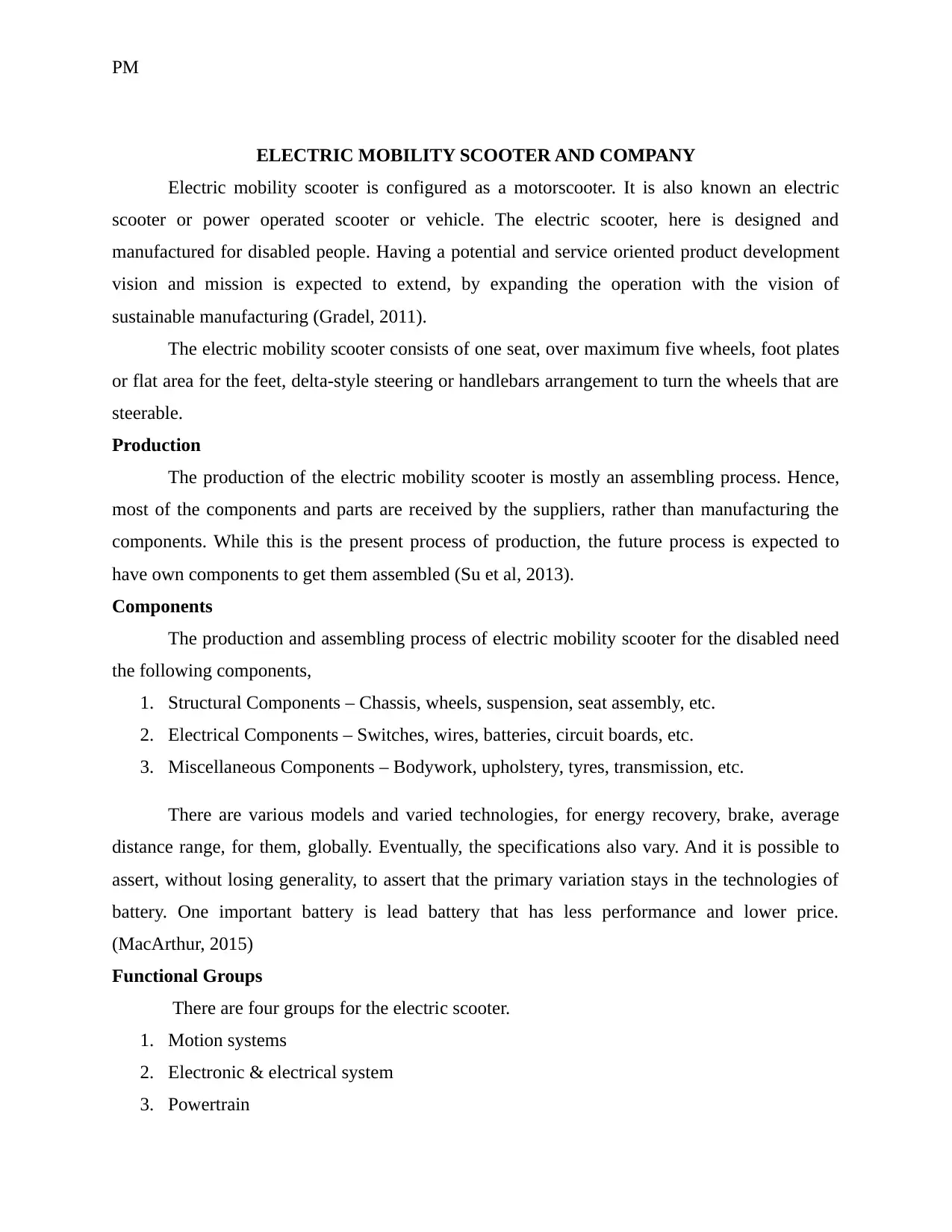
PM
ELECTRIC MOBILITY SCOOTER AND COMPANY
Electric mobility scooter is configured as a motorscooter. It is also known an electric
scooter or power operated scooter or vehicle. The electric scooter, here is designed and
manufactured for disabled people. Having a potential and service oriented product development
vision and mission is expected to extend, by expanding the operation with the vision of
sustainable manufacturing (Gradel, 2011).
The electric mobility scooter consists of one seat, over maximum five wheels, foot plates
or flat area for the feet, delta-style steering or handlebars arrangement to turn the wheels that are
steerable.
Production
The production of the electric mobility scooter is mostly an assembling process. Hence,
most of the components and parts are received by the suppliers, rather than manufacturing the
components. While this is the present process of production, the future process is expected to
have own components to get them assembled (Su et al, 2013).
Components
The production and assembling process of electric mobility scooter for the disabled need
the following components,
1. Structural Components – Chassis, wheels, suspension, seat assembly, etc.
2. Electrical Components – Switches, wires, batteries, circuit boards, etc.
3. Miscellaneous Components – Bodywork, upholstery, tyres, transmission, etc.
There are various models and varied technologies, for energy recovery, brake, average
distance range, for them, globally. Eventually, the specifications also vary. And it is possible to
assert, without losing generality, to assert that the primary variation stays in the technologies of
battery. One important battery is lead battery that has less performance and lower price.
(MacArthur, 2015)
Functional Groups
There are four groups for the electric scooter.
1. Motion systems
2. Electronic & electrical system
3. Powertrain
ELECTRIC MOBILITY SCOOTER AND COMPANY
Electric mobility scooter is configured as a motorscooter. It is also known an electric
scooter or power operated scooter or vehicle. The electric scooter, here is designed and
manufactured for disabled people. Having a potential and service oriented product development
vision and mission is expected to extend, by expanding the operation with the vision of
sustainable manufacturing (Gradel, 2011).
The electric mobility scooter consists of one seat, over maximum five wheels, foot plates
or flat area for the feet, delta-style steering or handlebars arrangement to turn the wheels that are
steerable.
Production
The production of the electric mobility scooter is mostly an assembling process. Hence,
most of the components and parts are received by the suppliers, rather than manufacturing the
components. While this is the present process of production, the future process is expected to
have own components to get them assembled (Su et al, 2013).
Components
The production and assembling process of electric mobility scooter for the disabled need
the following components,
1. Structural Components – Chassis, wheels, suspension, seat assembly, etc.
2. Electrical Components – Switches, wires, batteries, circuit boards, etc.
3. Miscellaneous Components – Bodywork, upholstery, tyres, transmission, etc.
There are various models and varied technologies, for energy recovery, brake, average
distance range, for them, globally. Eventually, the specifications also vary. And it is possible to
assert, without losing generality, to assert that the primary variation stays in the technologies of
battery. One important battery is lead battery that has less performance and lower price.
(MacArthur, 2015)
Functional Groups
There are four groups for the electric scooter.
1. Motion systems
2. Electronic & electrical system
3. Powertrain

PM
4. Structure System
Figure: General Scooter Sketch (Jawahir et al, 2013)
SUSTAINABLE MANUFACTURING
Sustainable manufacturing is a complex system problem, essentially, because it involves
considerations of three integral interacting levels, products, processes and systems (Jayal et al,
2010). There are several insufficient attempts that include integral approach partially and almost
fall short, since they deal largely with processes and products, however fail to emphasize the
three integral elements interconnectivity involved in the system of manufacturing and show the
sustainable value creation basis, for economic growth.
Sustainable manufacturing offers a new production way to make functionally superior
product with the advanced manufacturing methods, sustainable technologies, however, only if
the production, design of supply chain and design of product and enterprise and management
level logistics are well understood, managed and developed in an integrated and holistic ways.
4. Structure System
Figure: General Scooter Sketch (Jawahir et al, 2013)
SUSTAINABLE MANUFACTURING
Sustainable manufacturing is a complex system problem, essentially, because it involves
considerations of three integral interacting levels, products, processes and systems (Jayal et al,
2010). There are several insufficient attempts that include integral approach partially and almost
fall short, since they deal largely with processes and products, however fail to emphasize the
three integral elements interconnectivity involved in the system of manufacturing and show the
sustainable value creation basis, for economic growth.
Sustainable manufacturing offers a new production way to make functionally superior
product with the advanced manufacturing methods, sustainable technologies, however, only if
the production, design of supply chain and design of product and enterprise and management
level logistics are well understood, managed and developed in an integrated and holistic ways.
⊘ This is a preview!⊘
Do you want full access?
Subscribe today to unlock all pages.

Trusted by 1+ million students worldwide
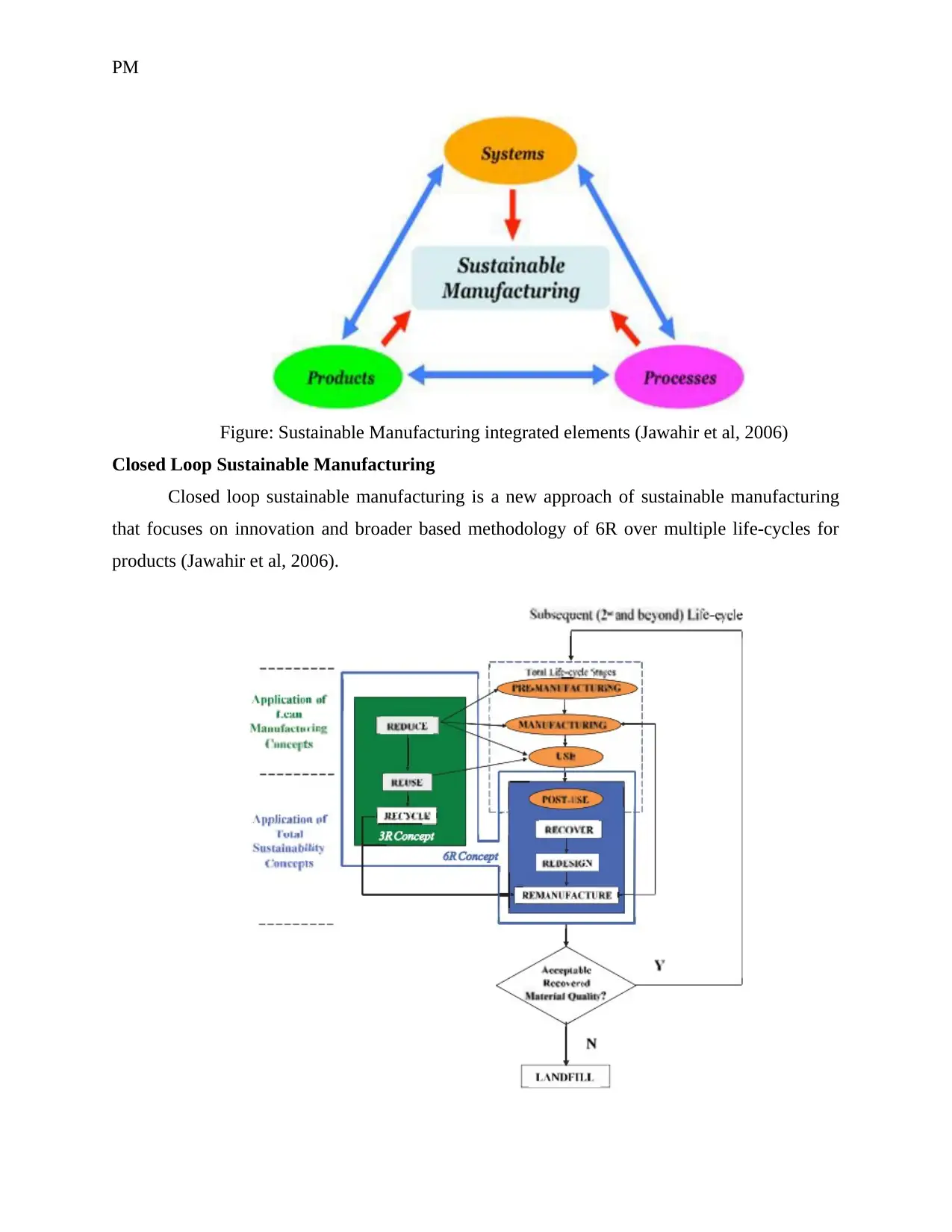
PM
Figure: Sustainable Manufacturing integrated elements (Jawahir et al, 2006)
Closed Loop Sustainable Manufacturing
Closed loop sustainable manufacturing is a new approach of sustainable manufacturing
that focuses on innovation and broader based methodology of 6R over multiple life-cycles for
products (Jawahir et al, 2006).
Figure: Sustainable Manufacturing integrated elements (Jawahir et al, 2006)
Closed Loop Sustainable Manufacturing
Closed loop sustainable manufacturing is a new approach of sustainable manufacturing
that focuses on innovation and broader based methodology of 6R over multiple life-cycles for
products (Jawahir et al, 2006).
Paraphrase This Document
Need a fresh take? Get an instant paraphrase of this document with our AI Paraphraser

PM
Figure: Sustainable Manufacturing Multiple product life-cycle (Joshi et al, 2006)
In the methodology of 6R, the main focus of Reduce is on the product life-cycle’s first
three stages and refers to the resources reduced usage in pre-manufacturing, reduced materials,
energy and other resources usage during manufacturing and reduction in waste and emissions
during the stage of usage. Here, reuse refers to the product reuse as its components or as a whole,
for first and following life-cycles so that virgin material usage reduction to produce newer
components and products.
The focus of Recycle is on the material conversion process for the materials considered as
waste, into new products or materials. Recover is the process of products collection at the end of
each of the stage of usage, disassembling, cleaning and sorting towards utilization, for further
product life-cycles. The activity of Redesign involves the next generation products redesigning
act that make use of materials, components and resources recovered from the previous products
generation or previous life-cycles (EPA, 2014). The process of Remanufacture is already used
products’ re-processing towards restoration to the like-new form or to their original state form,
through the many parts usage as possible, with no functionality loss.
Figure: Sustainable Manufacturing Multiple product life-cycle (Joshi et al, 2006)
In the methodology of 6R, the main focus of Reduce is on the product life-cycle’s first
three stages and refers to the resources reduced usage in pre-manufacturing, reduced materials,
energy and other resources usage during manufacturing and reduction in waste and emissions
during the stage of usage. Here, reuse refers to the product reuse as its components or as a whole,
for first and following life-cycles so that virgin material usage reduction to produce newer
components and products.
The focus of Recycle is on the material conversion process for the materials considered as
waste, into new products or materials. Recover is the process of products collection at the end of
each of the stage of usage, disassembling, cleaning and sorting towards utilization, for further
product life-cycles. The activity of Redesign involves the next generation products redesigning
act that make use of materials, components and resources recovered from the previous products
generation or previous life-cycles (EPA, 2014). The process of Remanufacture is already used
products’ re-processing towards restoration to the like-new form or to their original state form,
through the many parts usage as possible, with no functionality loss.

PM
Figure: Closed Loop System, based on 6R (Jaafar et al, 2007)
6R based closed loop system enable material flow as ‘near-perpetual’, with the optimal
usage of raw materials, energy and many other resources and able to product reduced emissions
and wastes by the end (Jaafar et al, 2007).
Figure: Closed Loop System, based on 6R (Jaafar et al, 2007)
6R based closed loop system enable material flow as ‘near-perpetual’, with the optimal
usage of raw materials, energy and many other resources and able to product reduced emissions
and wastes by the end (Jaafar et al, 2007).
⊘ This is a preview!⊘
Do you want full access?
Subscribe today to unlock all pages.

Trusted by 1+ million students worldwide
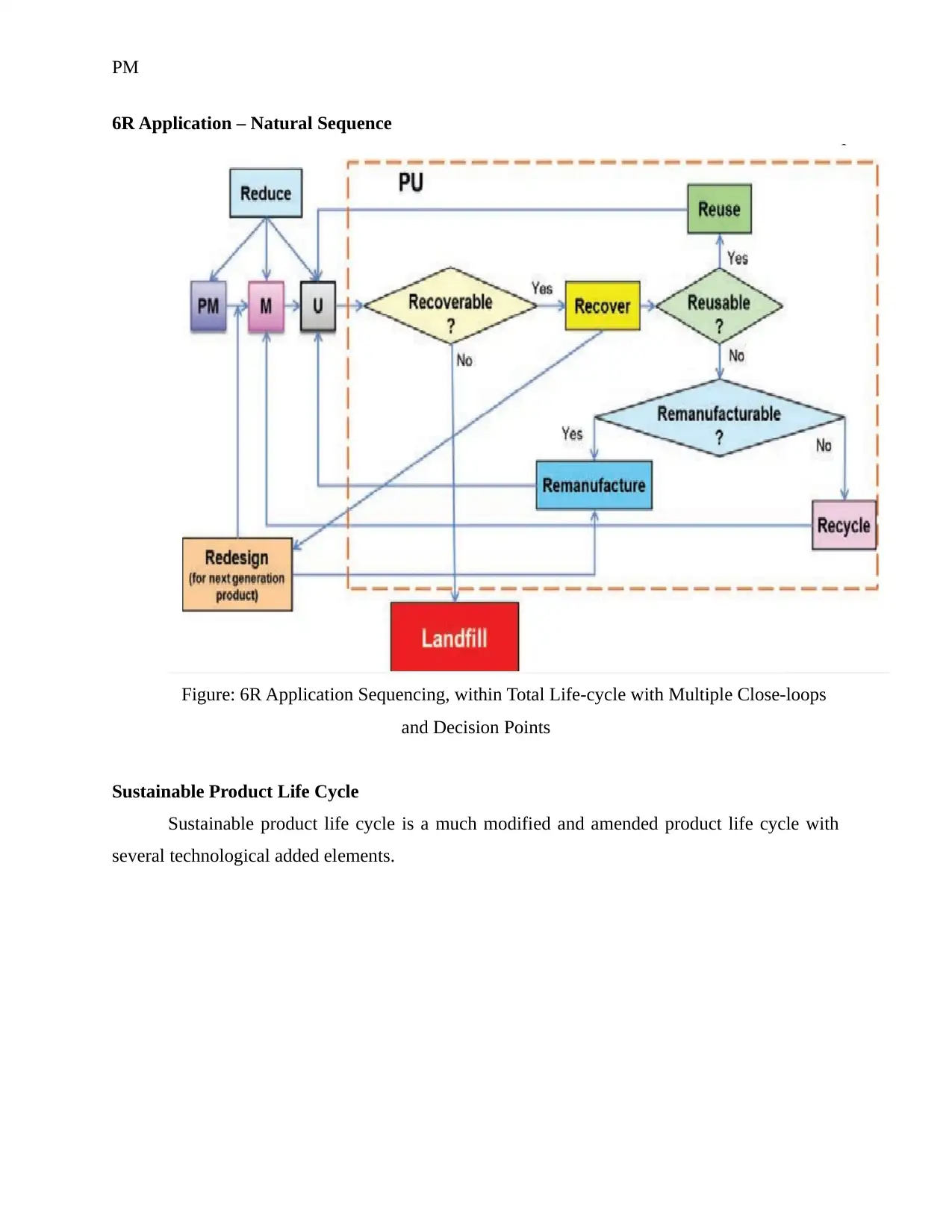
PM
6R Application – Natural Sequence
Figure: 6R Application Sequencing, within Total Life-cycle with Multiple Close-loops
and Decision Points
Sustainable Product Life Cycle
Sustainable product life cycle is a much modified and amended product life cycle with
several technological added elements.
6R Application – Natural Sequence
Figure: 6R Application Sequencing, within Total Life-cycle with Multiple Close-loops
and Decision Points
Sustainable Product Life Cycle
Sustainable product life cycle is a much modified and amended product life cycle with
several technological added elements.
Paraphrase This Document
Need a fresh take? Get an instant paraphrase of this document with our AI Paraphraser
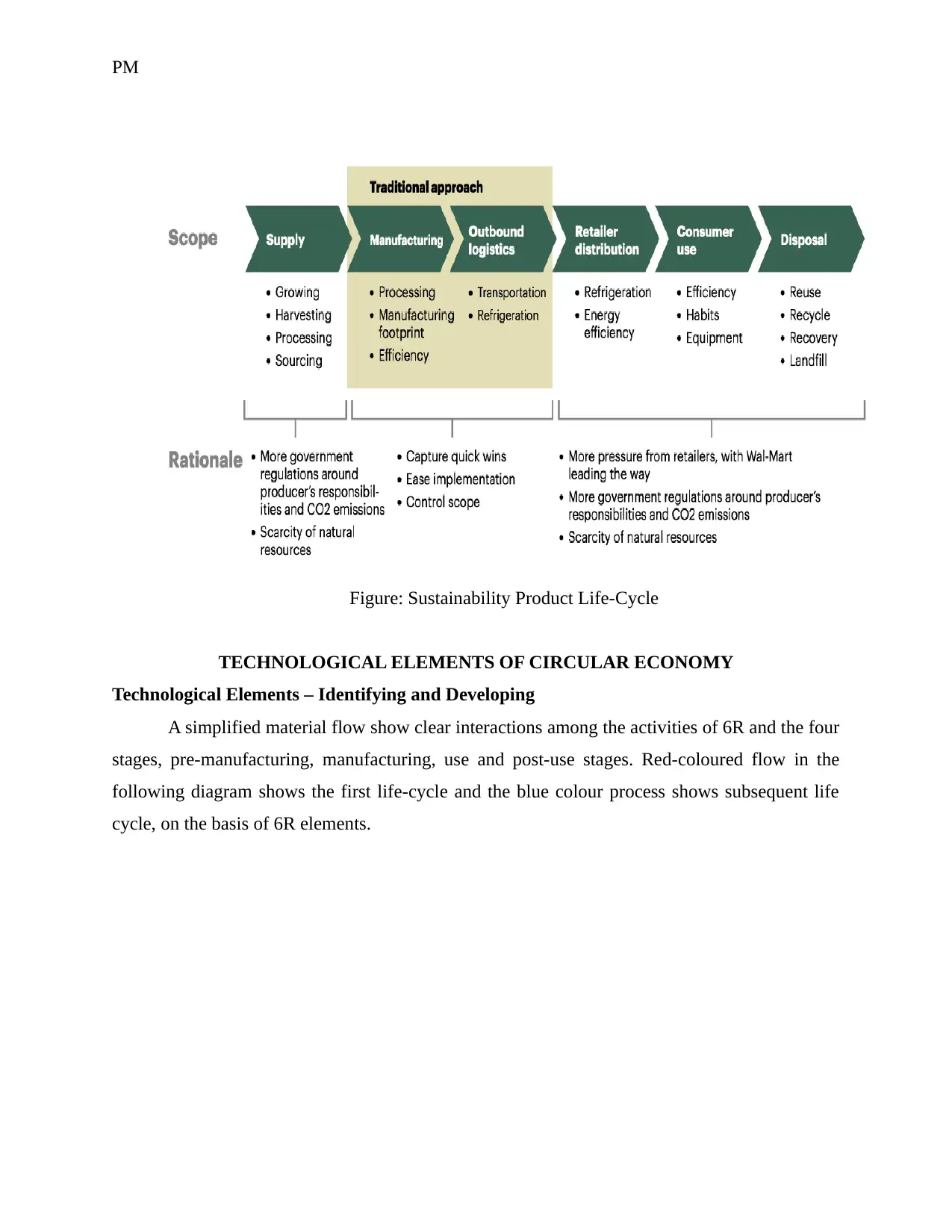
PM
Figure: Sustainability Product Life-Cycle
TECHNOLOGICAL ELEMENTS OF CIRCULAR ECONOMY
Technological Elements – Identifying and Developing
A simplified material flow show clear interactions among the activities of 6R and the four
stages, pre-manufacturing, manufacturing, use and post-use stages. Red-coloured flow in the
following diagram shows the first life-cycle and the blue colour process shows subsequent life
cycle, on the basis of 6R elements.
Figure: Sustainability Product Life-Cycle
TECHNOLOGICAL ELEMENTS OF CIRCULAR ECONOMY
Technological Elements – Identifying and Developing
A simplified material flow show clear interactions among the activities of 6R and the four
stages, pre-manufacturing, manufacturing, use and post-use stages. Red-coloured flow in the
following diagram shows the first life-cycle and the blue colour process shows subsequent life
cycle, on the basis of 6R elements.
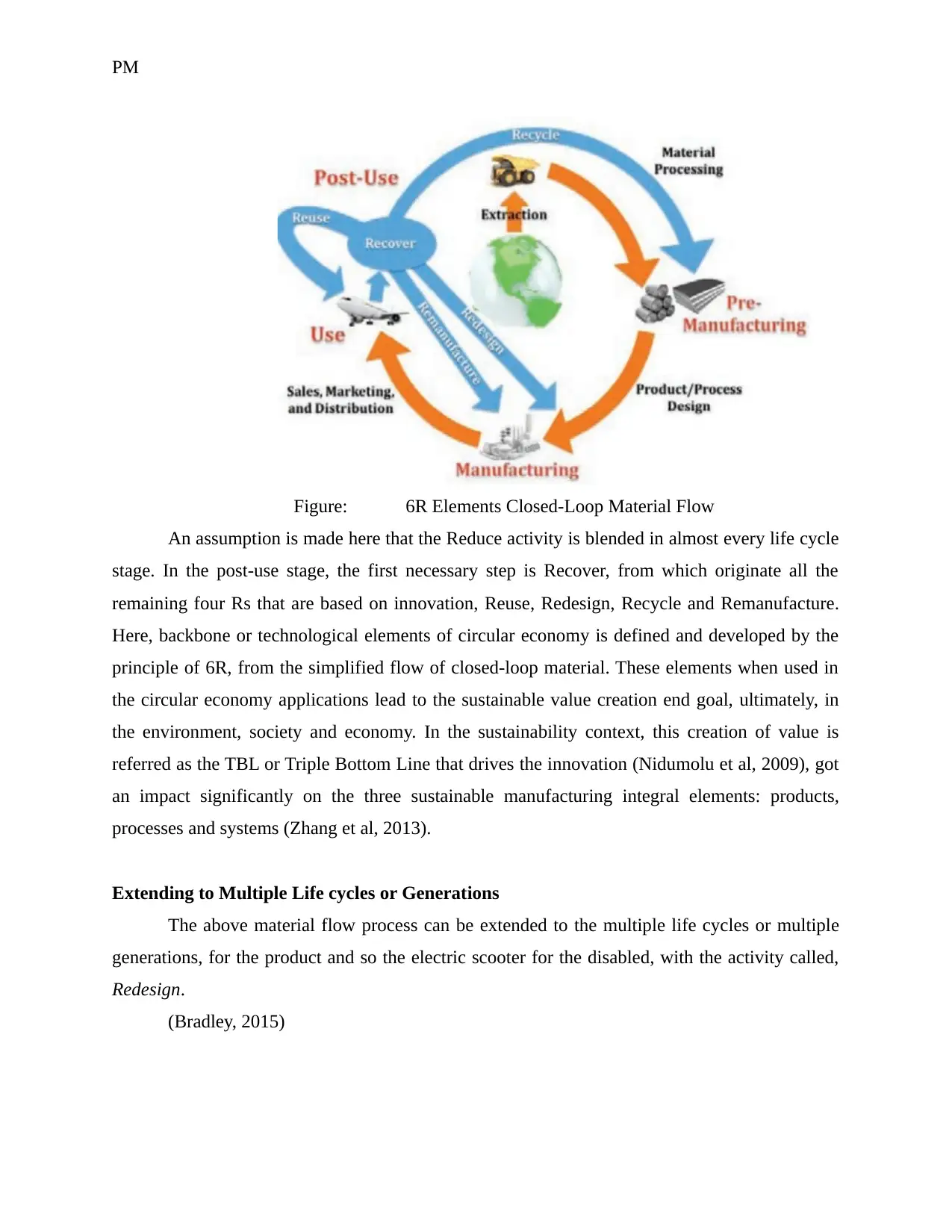
PM
Figure: 6R Elements Closed-Loop Material Flow
An assumption is made here that the Reduce activity is blended in almost every life cycle
stage. In the post-use stage, the first necessary step is Recover, from which originate all the
remaining four Rs that are based on innovation, Reuse, Redesign, Recycle and Remanufacture.
Here, backbone or technological elements of circular economy is defined and developed by the
principle of 6R, from the simplified flow of closed-loop material. These elements when used in
the circular economy applications lead to the sustainable value creation end goal, ultimately, in
the environment, society and economy. In the sustainability context, this creation of value is
referred as the TBL or Triple Bottom Line that drives the innovation (Nidumolu et al, 2009), got
an impact significantly on the three sustainable manufacturing integral elements: products,
processes and systems (Zhang et al, 2013).
Extending to Multiple Life cycles or Generations
The above material flow process can be extended to the multiple life cycles or multiple
generations, for the product and so the electric scooter for the disabled, with the activity called,
Redesign.
(Bradley, 2015)
Figure: 6R Elements Closed-Loop Material Flow
An assumption is made here that the Reduce activity is blended in almost every life cycle
stage. In the post-use stage, the first necessary step is Recover, from which originate all the
remaining four Rs that are based on innovation, Reuse, Redesign, Recycle and Remanufacture.
Here, backbone or technological elements of circular economy is defined and developed by the
principle of 6R, from the simplified flow of closed-loop material. These elements when used in
the circular economy applications lead to the sustainable value creation end goal, ultimately, in
the environment, society and economy. In the sustainability context, this creation of value is
referred as the TBL or Triple Bottom Line that drives the innovation (Nidumolu et al, 2009), got
an impact significantly on the three sustainable manufacturing integral elements: products,
processes and systems (Zhang et al, 2013).
Extending to Multiple Life cycles or Generations
The above material flow process can be extended to the multiple life cycles or multiple
generations, for the product and so the electric scooter for the disabled, with the activity called,
Redesign.
(Bradley, 2015)
⊘ This is a preview!⊘
Do you want full access?
Subscribe today to unlock all pages.

Trusted by 1+ million students worldwide
1 out of 23
Your All-in-One AI-Powered Toolkit for Academic Success.
+13062052269
info@desklib.com
Available 24*7 on WhatsApp / Email
![[object Object]](/_next/static/media/star-bottom.7253800d.svg)
Unlock your academic potential
Copyright © 2020–2025 A2Z Services. All Rights Reserved. Developed and managed by ZUCOL.

